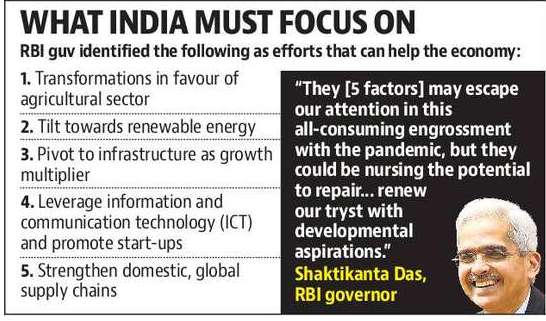Focus: GS-III Indian Economy
Why in news?
Reserve Bank of India (RBI) governor said five dynamic shifts have the potential to shape the future of the country’s economy.
He said the infrastructure gap still remains large and there is a need for diversifying financing options.

The Five Dynamic Shifts
I. Favoring Agricultural Sector
- The RBI Governor suggested a change in agriculture policy focus from minimum support price (MSP).
- An efficient domestic supply chain has a possibility to facilitate “domestic free trade” in agriculture that is triggered by three key policy changes — the amendment of the Essential Commodities Act (ECA), 1955; the Farmers’ Produce Trade and Commerce (Promotion and Facilitation) Ordinance, 2020; and the Farmers (Empowerment and Protection) Agreement on Price Assurance and Farm Services Ordinance, 2020.
- With this enabling legislative framework, the focus must turn to crop diversification, food processing, agricultural exports, and public and private capital formation in the farm sector.
II. Towards Renewable Energy
- In the case of renewables, there is clear scope for taking advantage of progressive cost reductions and substituting imports of solar panels from China by creating domestic capacity.
- India has emerged a power surplus country, exporting electricity to neighbouring countries, hence an opportunity exists in the energy sector, especially renewable energy.
III. Infrastructure as Growth multiplier
- In the case of infrastructure, the private sector already has a specific role in financing the National Infrastructure Pipeline (NIP)
- The current and next years are critical for the NIP since the proposed schedule provides for peaking of infrastructure investment in these years, particularly in the construction sector.
- Financing of infrastructure investment in the current and subsequent years will be key to the recovery of India’s growth and pushing it towards its potential.
- To finance public investment in infrastructure, the government may consider another round of fiscal stimulus focused mainly on increasing its capital expenditure on infrastructure.
IV. Information and Communications Technology (ICT)
- In the case of information and communication technology, the government’s initiatives for curbing Chinese technologies and applications open up competitive space for Indian initiatives.
- Leveraging information and communication technology (ICT) and focusing on start-ups has the potential to help in India’s Economic growth plans.
V. Domestic and Global Supply Chains
- Global shifts in value chains in response to Covid-19 and other developments would create opportunities for India.
- Besides focusing on diversifying sources of imports, it may also be necessary to focus on greater strategic trade integration, including in the form of early completion of bilateral free trade agreements with the US (United States), the EU (European Union), and the UK (United Kingdom).
- Global supply chains are bound to be realigned in favour of the country and the private sector should invest extensively and take advantage of the space that is being opened up.
-Source: Hindustan Times, The Hindu




